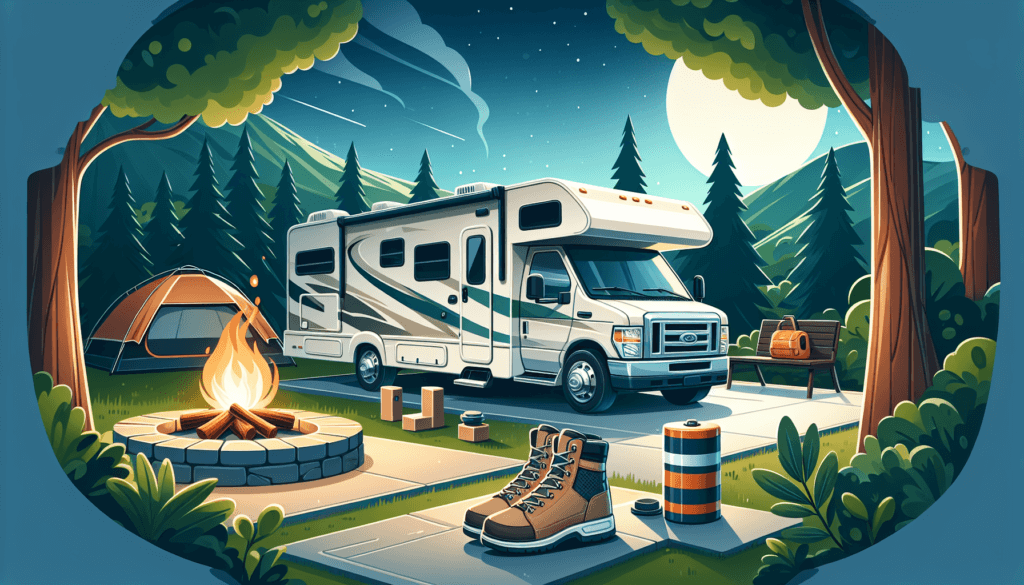Imagine this scenario: you’ve finally arrived at your dream camping spot with your trusty RV in tow. You’re ready to unwind and enjoy the great outdoors, but there’s just one problem – your RV is not level. As any experienced camper knows, an unlevel RV can be a major inconvenience, causing discomfort and potentially damaging your vehicle. In this article, we will guide you through the essential steps on how to level an RV, ensuring a comfortable and enjoyable camping experience. So, let’s dive in and get your RV perfectly level for your next adventure!

Importance of Leveling an RV
When it comes to RV camping, one of the most important tasks is leveling your vehicle. Not only does this ensure your safety and the safety of others, but it also contributes to the proper functioning of your appliances and the overall comfort and convenience of your living space.
Prevent Accidents and Injuries
Leveling your RV plays a crucial role in preventing accidents and injuries. Uneven surfaces can cause your RV to tilt or lean, posing a significant risk. Inside the RV, an uneven surface can make it difficult to move around, leading to tripping or falling accidents. Leveling your RV properly helps to eliminate these hazards, providing a stable and secure living environment for you and your fellow campers.
Ensure Proper Functioning of Appliances
Leveling your RV is not just about safety; it also affects the functioning of your appliances. Many appliances in an RV, such as refrigerators and stoves, rely on gravity and proper balance to operate efficiently. If your RV is not level, these appliances may not work correctly, affecting your ability to cook, store food, or even keep your drinks cold. By properly leveling your RV, you ensure that these appliances function as intended, adding convenience to your camping experience.
Maintain Comfort and Convenience
Lastly, leveling your RV contributes to the overall comfort and convenience of your camping trip. It ensures that your sleeping quarters are level, allowing for a good night’s sleep without rolling to one side. It also prevents doors and cabinets from swinging open or shutting on their own. By leveling your RV, you create a comfortable and stable living space, making your camping experience more enjoyable and relaxing.
Tools and Equipment for Leveling an RV
To successfully level your RV, you need the right tools and equipment. Here are some essential items you will need:
Leveling Blocks
Leveling blocks are an essential tool for RV leveling. These blocks, usually made of durable plastic, can be stacked under the RV wheels to raise or lower specific areas, effectively leveling the vehicle. They come in various heights and sizes, allowing you to customize the leveling process according to your RV’s specific needs.
Leveling Jacks
Leveling jacks are hydraulic systems designed to lift and stabilize your RV. They are typically located near each wheel and can be extended or retracted, providing the necessary adjustments for leveling. These jacks offer a more automated and precise leveling process compared to using leveling blocks.
Bubble Level or Smartphone Leveling App
A bubble level or smartphone leveling app is a handy tool for checking the levelness of your RV. A bubble level is a small, plastic device with a liquid-filled tube and an air bubble. You can place it on a flat surface inside your RV to determine if it is level. Alternatively, smartphone leveling apps use the built-in gyroscope of your phone to provide digital leveling readings.
Chocks or Wheel Stops
Chocks or wheel stops are devices used to prevent your RV from rolling or moving while parked. They are typically placed on both sides of the wheels to ensure stability and prevent unintended movement. Chocks are made of sturdy materials such as rubber or metal and are an essential part of the RV leveling process.
Preparing the RV for Leveling
Before you begin leveling your RV, there are a few steps you should take to ensure a smooth and successful leveling process.
Choose the Right Campsite
Selecting the right campsite is crucial for the leveling process. Look for a site that is as level as possible. Avoid parking on uneven terrain, slopes, or areas prone to flooding. Choosing a level campsite will make the leveling process easier and more effective.
Park the RV on a Level Surface
Once you’ve found the ideal campsite, position your RV on the flattest part of the ground. This will provide a solid foundation for leveling. If necessary, use your vehicle’s backup camera or have someone guide you to ensure proper alignment and positioning.
Securely Set the Parking Brake
Before attempting to level your RV, make sure to securely set the parking brake. This will prevent your RV from rolling or moving during the leveling process, ensuring your safety and the integrity of the leveling adjustments you make.
Using Leveling Blocks to Level an RV
Leveling blocks are an effective and straightforward method for leveling an RV. Here’s how to use them:
Select the Proper Number of Blocks
Start by determining how many leveling blocks you will need on each side of the RV. This will depend on the specific leveling requirements and conditions of your campsite. As a general rule, you want to use a sufficient number of blocks to achieve a level and stable position for your RV.
Place the Blocks Under the Wheels
Position the leveling blocks in front of and behind the tires that need to be raised. Make sure to place the blocks in a straight line to prevent any tilting or instability.
Drive onto the Blocks Slowly and Steadily
With the blocks in place, slowly and steadily drive your RV onto them. Proceed with caution to ensure a smooth and controlled movement. As you drive onto the blocks, pay attention to any changes in the levelness of your RV and adjust accordingly. Once your RV is level, engage the parking brake and check the stability of the vehicle.

Leveling with Hydraulic Leveling Jacks
If your RV is equipped with hydraulic leveling jacks, you can take advantage of their automated leveling capabilities. Here’s how to level your RV using hydraulic jacks:
Locate and Extend the Jacks
Locate the hydraulic leveling jacks on your RV, usually positioned near each wheel. Extend the jacks by operating the control panel or system buttons, activating the hydraulics to lift your RV. Be sure to extend the jacks evenly on both sides.
Use a Bubble Level to Determine Levelness
Place a bubble level on a flat surface inside your RV, such as a countertop or table. Take note of the positioning of the air bubble to determine if your RV is level. Adjust the jacks as needed to achieve a level state. Make slight adjustments and recheck the levelness until your RV is properly leveled.
Adjust the Jacks to Level the RV
Using the feedback from the bubble level, adjust the individual jacks to level your RV. The hydraulic system allows for precise adjustments, ensuring that your RV is evenly balanced. Take your time with the leveling process and double-check with the bubble level to ensure accuracy.
Using a Bubble Level or Smartphone App
If you don’t have leveling blocks or hydraulic leveling jacks, you can rely on a bubble level or smartphone app to level your RV. Here’s how:
Place the Level on a Flat Surface Inside the RV
Position the bubble level on a flat surface inside your RV, such as a countertop or floor. Make sure the surface is stable and allows for accurate readings. Take note of the bubble’s position to determine if your RV is level or needs adjustments.
Adjust the Level by Adding or Removing Blocks
If your RV is not level, you can add or remove leveling blocks under the wheels as necessary. Start with a small adjustment and recheck the levelness using the bubble level. Repeat the process until your RV is level. Ensure that the blocks are securely positioned and provide stable support.
Use a Smartphone App for More Precision
Alternatively, you can use a smartphone leveling app for more precise leveling measurements. These apps utilize the gyroscope function of your phone to provide accurate readings. Place your phone on a stable surface and follow the app’s instructions for leveling adjustments. Use caution when using your smartphone during the leveling process and ensure it is secure to prevent any accidents or damage.

Stabilizing the RV with Chocks or Wheel Stops
After leveling your RV, it’s essential to stabilize it to prevent any movement or rolling while parked. Here’s how to use chocks or wheel stops:
Place Chocks or Wheel Stops
Position chocks or wheel stops on both sides of the wheels that need to be stabilized. Place them snugly against the tires, ensuring a secure fit. Chocks come in various sizes, so choose the appropriate size for your RV’s wheel diameter to ensure optimal stability.
Position them on Both Sides of the Wheels
For maximum stability, place chocks or wheel stops on both sides of the wheels. This helps to prevent any rolling or movement, especially on inclines or uneven surfaces. You can use additional chocks if needed to further secure your RV.
Check for Stability and Adjust as Needed
Once the chocks or wheel stops are in place, check for stability by gently pushing against the RV or attempting to rock it back and forth. If there is any movement, adjust the chocks or wheel stops accordingly to ensure a stable and secure position.
Testing the Levelness of the RV
To ensure that your RV is properly leveled, perform a few tests to confirm its levelness. Here’s what you should do:
Check the Levelness with a Bubble Level
Revisit your bubble level and double-check the levelness of your RV after stabilizing it. Verify that the bubble is centered or aligned in the indicator for a perfectly level RV. Make any necessary adjustments to achieve the desired levelness.
Ensure the Doors and Cabinets Close Properly
Walk through your RV and test the functionality of the doors and cabinets. If the RV is properly leveled, they should open and close smoothly, without any resistance or swinging. Adjust the leveling if necessary to ensure proper functionality.
Observe the Flow of Liquids in Containers
Finally, observe the flow of liquids in containers placed on countertops or tables. If your RV is level, the liquids should remain still or flow naturally without any tilting or spilling. If you notice any abnormalities, it may indicate an imbalance, requiring further adjustments to level your RV.

Additional Tips for Leveling an RV
Here are some additional tips to enhance your RV leveling experience:
Use a Second Level for Cross-Referencing
To ensure accuracy, consider using a second level for cross-referencing. Different levels may provide slightly different readings, so having a backup level can help you double-check the levelness of your RV.
Avoid Over-Extending Jacks or Blocks
When using leveling jacks or blocks, avoid overextending them. Overextending can put unnecessary strain on the jacks or cause the blocks to become unstable. Follow the manufacturer’s instructions for proper usage and avoid any potential damage or accidents.
Regularly Check and Maintain Leveling Equipment
Periodically inspect and maintain your leveling equipment for optimal performance. Check for any signs of wear or damage and replace as necessary. Keep your leveling blocks clean and store them properly to prolong their lifespan. Additionally, ensure the hydraulic leveling jacks are lubricated and functioning correctly.
Conclusion
Leveling your RV is a crucial step to create a comfortable and safe camping experience. By prioritizing RV leveling, you prevent accidents and injuries, ensure the proper functioning of appliances, and maintain overall comfort and convenience. Utilize the necessary tools and equipment, such as leveling blocks, hydraulic leveling jacks, bubble levels, and chocks or wheel stops, for an effective leveling process. Take the time to prepare your RV, choose the right campsite, and securely set the parking brake. Whether using leveling blocks, hydraulic jacks, or a bubble level or smartphone app, follow the step-by-step instructions provided to achieve a level RV. Stabilize your RV with chocks or wheel stops and perform tests to confirm the levelness. Lastly, remember these additional tips, including using a second level for cross-referencing, avoiding over-extending jacks or blocks, and regularly checking and maintaining your leveling equipment. By following these guidelines, you can prioritize leveling and enjoy a comfortable, safe, and stable camping experience in your RV.



